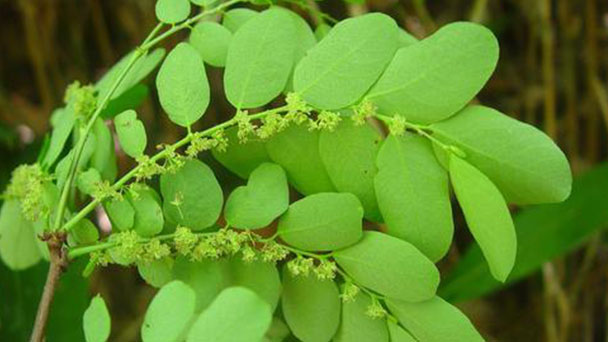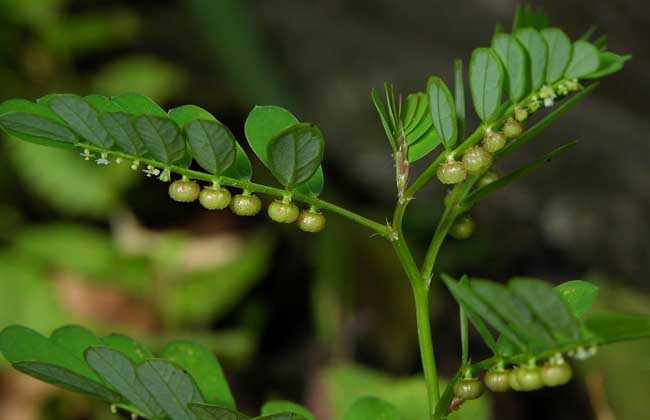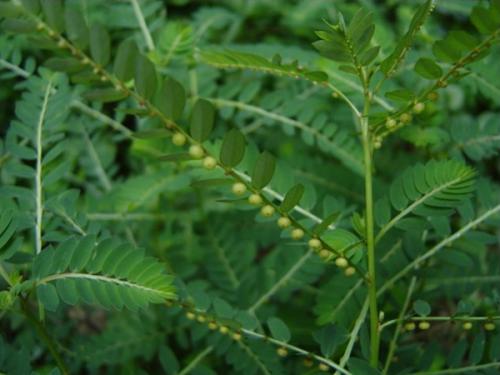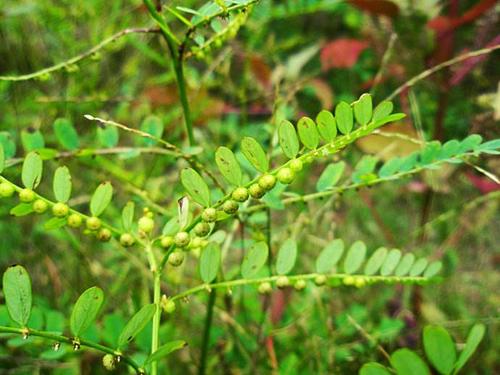Phyllanthus urinaria (Chamberbitter) profile
Written by Maggie
Oct 13 2021

Phyllanthus urinaria, also called chamber bitter, gripeweed, shatterstone, stonebreaker or leafflower, is an annual herb a few inches to a few feet tall. Phyllanthus urinaria stem is purplish red, longitudinal. Leaves are alternate, make tile-like arrangement, form two rows, very similar to the pinnate compound leaves, leaf moments round, two or three long, all green, apex pointed or blunt, base round, almost without petiole. Summer and autumn along the stems and leaves below the white flowers, no flower stalk. After the flower knot oblate round the small fruit, the shape is like a small bead, arranged in the false compound leaf below.
Phyllanthus urinaria picture

Morphological characteristics of Phyllanthus urinaria
Phyllanthus urinaria, annual, 10-60 cm tall, stems are usually erect, base much branched, branches decumbent and then ascending; Branches are winged longitudinally, distally covered - longitudinally sparsely pubescent.
Phyllanthus urinaria leaves are papery, pinnately arranged by torqued petioles, oblong or obovate, 4 -- 10 mm long and 2 -- 5 mm wide, rounded, obtuse or acute with a small point at the apex, grey-green below, with 1 -- 3 rows of short coarse hairs near the margin or margin; Lateral veins are 4-5 on each side, conspicuous; Petiole is very short; Stipules are ovate-lanceolate, ca. 1.5 mm.
Flowers of phyllanthus urinaria are monoecious, ca. 4 mm in diameter; Male flowers: 2-4 clustered in leaf axils, usually only the upper flowering, the lower one very small; Pedicels ca. is 0.5 mm, base bracts 1-2; Phyllanthus urinaria has 6 sepals, obovate, ca. 0.6 mm long, apex obtuse; Phyllanthus urinaria has 3 stamens, filaments all connate into columnar;P ollen grains are long spherical, usually with 5-well groove, a few 3, 4, 6-well groove, inner pore transverse long elliptic; Phyllanthus urinaria has 6 disk glands, separated, alternate with sepals; Female flowers: solitary in leaf axils of lower middle branchlets; Pedicels ca. are 0.5 mm; Phyllanthus urinaria has 6 sepals, subequal, ovate-lanceolate, ca. 1 mm long, margin membranous, yellow-white; Disk is discoid, margin entire; Ovary is ovate, scale-like, style detached, apical 2-lobed, lobes curving. Capsule is globose, 1 -- 2 mm in diam., red, surface -spinules, with persistent styles and sepals, dehiscent posteriorly axillary persistent; Seeds are 1.2 mm long and orange.
Ecological habits of Phyllanthus urinaria
Phyllanthus urinaria mostly grows in warm and humid areas with loose soil, and is slightly tolerant to shade. The soil quality of the growing areas is mainly forest brown soil and sandy soil, and the soil pH is 5.8~7.0.
Phyllanthus urinaria is found in shrubs or under sparse forests at altitudes of 200 to 1,000 meters.
How to grow and care for Phyllanthus urinaria
Hoe weeding
Phyllanthus Urinaria generally concentrates on weeding 3 times a year, weeding 1 time in late spring, weeding 1 time in late June and 1 time in mid-August with small hoes, with a depth of 3cm, and pulling out at any time depending on the weeds at ordinary times. The use of herbicides is strictly prohibited.
Irrigation water
During long periods of drought, furrow irrigation should be used to allow water to seep into the border along the operating channel; Drains should be cleared before the rainy season to ensure that the field is free of water.
Fertilizer
Phyllanthus urinaria was in the vigorous growth period in summer, and 300kg of diammonium phosphate compound fertilizer and 150kg of urea could be applied per hectare in combination with weeder.
The propagation of Phyllanthus urinaria
Phyllanthus urinaria's common method of propagation is seeding.
Phyllanthus urinaria was determined to have a 1000-seed weight of 0.52kg, a germination rate of 63% and a seed use of 7.5kg per hectare. The sowing method is best to drill, in the furrow surface every 20cm deep 2cm rill, seeds and fine soil mix well and then sprinkle into the furrow, with the rake back gently flat cover the furrow surface.

Species taxonomy of Phyllanthus urinaria
Identification method
Phyllanthus urinaria (chamberbitter) is preferred for fruity, grey-green colors, and sand-free.
Transverse section of stem: quasi-orbicular, 5-10 - rowed.The epidermal cells are rectangular and the outer wall is slightly thick. There are 2-3 rows of thick cells in the outer cortex, and the edges are more developed. The parenchyma cells are elliptic or round, and the cells are gradually larger inward.
The pericyst fiber bundle is cap-shaped and located lateral to phloem. The vascular bundle is ductile. The cambium is usually not obvious.Xylem vessels round or elliptic, 13-33μm in diameter, scattered singly or in groups of 2-3; Wood ray is 1 row cell wide, the wall is slightly thick, woody. The pulp is often due to the rupture of parenchyma cells into a cavity leaf cross-section: upper and lower epidermal cells are similar, like round, oval or irregular shape, the lateral side is often slightly papillary; Leaf green epidermis surrounded by cuticle laterally. Mesophyll cells were not differentiated and parenchyma cells contained calcium oxalate tablets. The main vascular bundles are tough-shaped with well-developed xylem.
Leaf surface view
The upper and lower epidermal cells are polygonal or rectangular, and the anticline wall is straight. Stomatal 1000 axis type. Corneous protuberance is common in leaf margin cells.For physical and chemical identification, 1g of powder was taken, 10mL of methanol was added, reflux extraction was carried out for 30min, and then filtered. Take 5ml of filtrate, add a small amount of hydrochloric acid and magnesium powder to make it orange red.
The distribution region of Phyllanthus urinaria
Phyllanthus urinaria is distributed in Sichuan (the highest content of gallic acid is produced in Daxue Mountain of Sichuan), Yunnan, Hunan, Guizhou, Guangdong, Guangxi, Jiangsu, Jiangxi, Fujian, Zhejiang, Anhui and other provinces. It is collected in summer and autumn.
Phyllanthus urinaria uses
Phyllanthus urinaria leaves are slightly bitter, cool and non-toxic, into the liver and spleen meridian. The main treatment is red and white dysentery, heat diarrhea, enteritis diarrhea, urinary tract infection, nephritis edema, night blindness, acute conjunctivitis, mouth sores, head sores, wind fire red eyes, simple indigestion, infantile malnutrition. External treatment of snake bite, finger snake sores, skin flying snake eggs, children's summer furuncle, etc.

Read Next: Chamberbitter Control: How to Get Rid of Gripeweed
Latest Updated
- Benefits of Bugleweed - 7 Science-backed Health Benefits
- Bugleweed Dangers & Side Effects - Is It Poisonous?
- How to Plant Evergreen Trees - What You Should Know
- When to Plant Evergreens - Grow Guide for Evergreen Trees
- 12 Wonderful Evergreen Shrubs for Your Garden
- 12 Popular Evergreen Plants with Pictures for Beginners
- When And How To Prune A Lilac Bush Like a Pro
- How to Grow & Care for Lilac Vine (Hardenbergia Violacea)
- Japanese Lilac Tree (Syringa Reticulata) Care & Propagation Guide
- Shumard Oak Pros and Cons - What to Know
Popular Articles
- Winter maintenance of Antirrhinum Majus
- How to Grow Terminalia Mantaly Tree
- How to Grow and Care for Crossostephium Chinense
- How to grow Antirrhinum Majus in spring
- Peristeria Elata (Dove Orchid) Profile: Info & Care Guide
- Underwatered Snake Plant (Sansevieria Trifasciata) - Signs And How To Fix
- How to Care for Brazilian Jasmine Plant (Mandevilla Sanderi)
- How to Grow & Care for Graptopetalum Purple Delight in Summer
- Rosa Chinensis (China Rose): Plant Growing & Care Tips
- How to Care for Baby Sun Rose (Aptenia Cordifolia)